Abstract
In today’s world, where communication has become fast and easy, people exchange their experiences with others. Reviews about products and services are posted online for people to read and decide their preferences. Such reviews are based on experiences that come from using certain products and/or services. Most people, who read such reviews, get influenced and believe what the reviews suggest.
So, it can be presumed that they are buying the experiences of others. Similarly, self-experiences of people play a crucial role in their future purchases of the same product/service. So, it is obvious that people buy experience instead of any product/service.
Under these circumstances and in order to achieve better performance, it has become imperative for businesses to concentrate on customer satisfaction. Due to the increasing global demand of various products, there is a stiff competition among companies to garner new customers and retain the existing ones.
Introduction
Today, customers buy experiences instead of goods and services. This particular trait of the customers’ choice and preference has been noticed during the past couple of years. Initially, marketing was based on goods that were manufactured and traded. The Industrial Revolution proved to be a shot in the arm for marketing as a system.
As there were incessant developments in the industrial field, new methods of marketing were developed in order to get better bargains for products and approach maximum possible customers.
Growth of similar industries also acted as a catalyst for innovations in marketing. Intensive global competition necessitated the organizations to concentrate on the satisfaction factor of customers. Gradually, rendering better service became the main criterion for businesses.
It is imperative to understand the marketing aspect before discussing the main topic of this assignment. For a layman, marketing is nothing but simply a tool for selling products or advertising the products. But when we look into the intricacies of marketing, it becomes evident that it is not merely selling or advertising but a lot more than our eyes can see.
What is marketing?
“Marketing is a management process that identifies, anticipates and supplies customer requirements – and makes sure it’s done efficiently and profitably” (Spreckley & Hunt 2008, p. 4). In other words, marketing is all about generating incredible features (of products and/or services) that might entice customers to buy.
Involving management in marketing makes things move systematically. Business strategy is one of the important tools of marketing management.
Business technique, in a fused manner, is the direction and opportunity of a company in the long-term which allows it to accomplish aggressive benefits through setting up its sources within a complicated atmosphere to fulfil the needs of the market and objectives of the stakeholders (Dess 2010).
Achievement of business objectives is an important survival goal for an organization. For accomplishment of business performance, objectives need to be established and explained by the upper management.
After sharing the objectives, they should be measured, appraised, monitored and appropriate actions should be taken. However, the performance and management process involves the entire business objectives evolution from its inception until its end.
Marketing helps the company management to think in a futuristic and systematic manner. This way, the management can foresee the market trends and can plan the products accordingly. Being systematic, marketing management builds a co-ordination in the efforts being made by various departments.
It also sets up better standards for performance in all fields. The objectives and policies of the company are clearly defined. All the departments of the company are well prepared for any sudden development.
There is nothing to panic about. Each and every person is allocated his/her duties and has to perform up to the expectations. Managers are involved in the decision making and as a result, the outcome is ‘perfection’.
Service v/s Goods
Initially, goods and services were well-defined and considered to be two different things altogether because both had their own set of characteristics. Goods are things that we can see, touch, feel, and smell. Once purchased, goods become tangible assets of the buyer. On the other hand, services are intangible and cannot be seen, touched, felt, or smelled (Rathmell 1966).
A customer can resell his/her goods but once a service has been availed, it cannot be resold because it has already been used. Comparing goods and services, it is easier to evaluate goods based on their appearance, but since services cannot be seen, it becomes very difficult to evaluate them unless they are used.
It means that the features of services are intangible (Zeithaml 1981). It implies that goods and services are two different things that cannot be compared. There are significant differences between goods and services due to the fact that evaluation of both of them is done in a different manner (Hartman & Lindgren 1993).
Today, distinguishing goods and services has reached a point of contention among authors. Vargo and Lusch (2004) argue that there is no specific difference between goods and services. According to them, both services and goods are based on customer satisfaction hence both are same as far as the customer is concerned.
They further claim that, “Service is defined as the application of specialized competences (operant resources—knowledge and skills), through deeds, processes, and performances for the benefit of another entity or the entity itself” (Vargo & Lusch 2008, p. 26).
If we consider the customers’ point of view, Vargo and Lusch are right to the extent that customers want better service if they are paying for some good or some service. There are four characteristics that customers generally look for in a service namely, “intangibility, inseparability, heterogeneity, and perishability” (Wolak, Kalafatis, & Harris 1998, p. 22).
More in-depth study reveals that there exists a demand for goods. They can be preserved and ownership can be claimed. They are meant solely for the person who owns them but can be exchanged with the owner’s consent. People can trade their goods in the free market and can earn profit (Parry, Newnes & Huang 2011). Services don’t have these characteristics.
They cannot be preserved and ownership cannot be claimed. Services are meant for a limited period of time and the same services can be rendered to various customers. The person who is availing any service cannot transfer or trade it for profit (Lusch & Vargo 2011).
The success of any business depends solely on the satisfaction of its customers. The business owners have to understand their customers’ expectations and needs and make arrangements for the availability of such products.
Different customers have different requirements and choices and as such, in retail business, the business owners have to have an assortment of products (McPartlin & Dugal 2011).
Offensive v/s defensive marketing
Businesses that are already in the market and have established themselves at some enviable position often adopt the defensive marketing strategy. This helps them in maintaining their position (Lister 2013).
But this doesn’t mean that if a company is at the top, it always uses defensive marketing strategy. There are times when competition increases and companies, that had previously adopted a defensive marketing strategy, might have to switch over to the offensive marketing strategy (Yannopoulos 2011).
Defensive marketing strategy
In defensive strategy, the main intention is to discourage new companies to enter any particular field. Businesses that are already in the market try to appear as if the profit pertaining to that field is very low and investments by new companies will not yield much. The following chart further elaborates the concept of defensive marketing strategy:
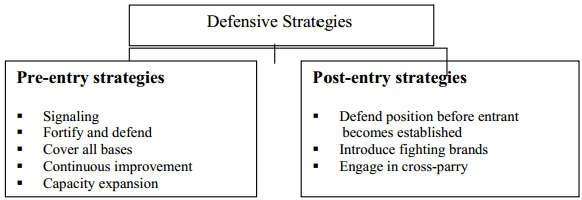
The above chart shows two stages at which defensive strategy is adopted. The pre-entry strategies are adopted when a new company is planning to enter the market but hasn’t launched officially. The following five steps add up to the pre-entry defensive marketing strategy:
- “Signalling”: In order to convey their message to new companies that are planning to enter the market, the established companies send signals via various mediums such as the print media and interviews.
- “Fortify and defend”: In order to discourage new entrants, the established companies tend to build obstacles (Fortify-and-defend strategy 2013, para. 1). It is a common practice to enter business areas where huge profit margin is expected (according to market reviews). The existing companies can even lower their product prices in order to discourage new entrants (Yannopoulos 2011).
- “Cover all bases”: This particular strategy calls for creating saturation in the market. It is expected that considering the saturation, new entrants might drop the idea of entering into that field.
- “Continuous improvement”: The existing companies are always in pursuit of excellence and innovation. This hinders new entrants to venture in the field because there is a possibility that they might not be able to be on a par with the existing companies and might fail.
- “Capacity expansion”: Another tool adopted by the existing companies is to increase their production capacity so that new entrants might not be able to match their capacities. It is believed that the production cost decreases as the production increases. So the cost of products of the existing companies will be at a range that the new entrants will not be able to match (Johansson & Furuskar n.d.).
The post-entry defensive marketing strategies are adopted when a new company has already entered into the market, unhindered by the pre-entry defensive marketing strategies of the existing companies. The following three steps add up to the post-entry defensive marketing strategy:
“Defend position before entrant becomes established” (Yannopoulos 2011, p. 4). The first and foremost motive of a new entrant is to make a foothold for itself in the market. Once this is done, the company can then concentrate on consolidating its place in the market and expanding its business.
It is not easy to get established in an area where there already are major players. But there are factors that can turn the market in favour of the new entrants such as innovative products and price-cut. The established companies indirectly try to threaten the new entrants of dire consequences if any such method is adopted.
“Introduce fighting brands”: In order to discourage new entrants, the established companies launch new versions of their branded and well-selling products that have the same features but are priced at a lower range. This strategy can help the existing companies to counterattack the price-cut strategy of the new entrants.
“Engage in cross-parry”: This is sort of a mutual understanding wherein companies agree not to interfere in each other’s markets. Both parties are happy doing business in their respective areas.
Offensive marketing strategy
The following chart depicts the various strategies adopted as part of an offensive marketing strategy:
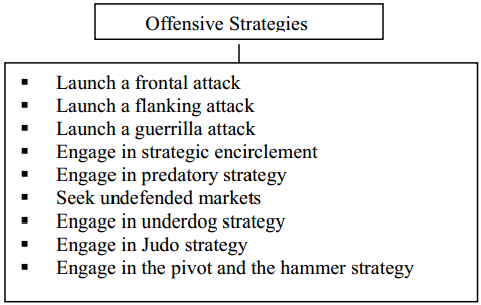
- Frontal attack: In this kind of strategy, the new entrants launch similar products of existing companies that have competent pricing and are at par quality wise as well.
- “Flanking attack”: In this kind of strategy, new entrants identify the weak points of the existing companies and concentrate on those areas. There are areas that the existing companies do not consider important and the new entrants take advantage of such areas.
- “Guerrilla attack”: There is not much of a difference between flanking attack and guerrilla attack. The main difference is that guerrilla attack might involve legal action.
- “Strategic encirclement”: Under this strategy, the companies plan to encircle their competitors in such a manner that there is no room for the competitor to expand. Precisely, the functions of competitors get confined to a small area. Subsequently, they cease to exist.
- “Predatory strategy”: In following this strategy, companies intend to lower their profit margins so that their products have rock-bottom prices. Competitors might find it tough to compete with such low prices.
- “Seek undefended markets”: Some new entrants adopt this strategy in order to avoid direct conflict with the existing companies.
- “Underdog strategy”: Such a strategy is adopted by relatively smaller new entrants who have the guts to face the existing bigger companies. In order to compete with such bigger competitors, the new entrants launch products with lower price and/or better quality.
- “Judo strategy”: This strategy is an expanded form of the underdog strategy (Yoffie & Kwak 2002).
- “Pivot and hammer strategy”: This strategy is a merger of offensive and defensive strategies (Dudik 2000).
Service-profit chain: profitability/customer loyalty/employee satisfaction
“The service-profit chain establishes relationships between profitability, customer loyalty, and employee satisfaction, loyalty, and productivity” (Heskett et al. 1994, p. 164). It is understood that profit and performance of a company depend mainly on the allegiance shown by customers.
Obviously, customers will swear allegiance only if they are satisfied. Satisfaction is largely dependent on the services provided by the company to its customers. A company’s market image depends on the satisfaction of its employees as well. How are employees satisfied? Well, it depends on the company’s policies pertaining to the employees (Heskett et al. 1994).
Value for the customer
“Customer value is a customer’s perceived preference for and evaluation of those product attribute performances, and consequences arising from use that facilitate (or block) achieving the customer’s goals and purposes in use situations” (Yamamoto n.d., p. 549).
According to this definition, the customer’s value increases or decreases depending on the level of service and quality provided by the company. This means that the customer decides after experiencing a particular product or service. Customers’ experiences are better if the expected results from the products or services are achieved.
According to Court et al. (2009), better value for products/services can be created by influencing them at the time when they are in need of that product/service like, for example, nowadays electronic products are displayed live in showrooms. Prospective buyers can have the experience of the products and decide their preferences.
For a customer, value doesn’t mean only the financial aspect. For them value means, “trust, affection, comfort, and easiness of use” (Korhonen 2012, p. 10). The value for customers can be increased by following certain criteria. Firstly, by increasing the customer base and subsequently the production capacity, business will flourish and the value for the customers will increase.
Secondly, the value for customers can be increased by increasing the profit margin. This can be done by decreasing overhead expenses. Companies’ distributors can play a vital role in increasing the value for customers. Finally, the kind of service provided by the distributors to customers and the consequent trust that will develop can increase the value for customers.
Value and evaluation
“Sound evaluations are grounded in clear and appropriate values (principles, attributes, or qualities held to be intrinsically good, desirable, important, and of general worth) and criteria (standards on which to base judgement)” (Stufflebeam 2001, p. 1). Evaluation should be done taking into consideration certain values. Following is an explanation of such values:
Societal values:
- Equity: While evaluating, care should be taken that there is no prejudice and decision is taken with fairness.
- Effectiveness: The ability of a company to meet the expected targets should be considered.
- Conservation: In their race to excel, companies should not disregard the environment.
- Excellence: Companies should have high standards.
- Citizenship: Companies ought to follow their Corporate Social Responsibility in an efficient manner.
- Freedom: People should not be forced to decide favourably for any product or service. They should be allowed to exercise their rights.
- Lawfulness: All prevalent laws should be followed strictly.
- National defence: Companies should ensure that their acts do not endanger the lives of other residents.
In addition to these values, a product or service should be able to match the desired product or service in order to be evaluated for positive results. The usefulness of the product or service for the desired objective is also a crucial factor considered while evaluating (Stufflebeam 2001).
Customer experience – co-creation of value
“From customers’ point of view service means using and integrating resources so that it will create value themselves in their practices. Resources as goods, service activities, and information are supplier’s resources that customers are using in their self-service process” (Korhonen 2012, p. 9).
This means that the value of a product or service is created depending on the customer’s experience. If the experience is good, the values will increase and if the experience is bad, the value will decrease. Experience will come only when the customer uses that particular product or service.
It has become a general practice for companies to involve its customers in various strategic decisions. Such collaboration helps the companies to create value (co-creation of value) for their products and/or services, based on the customers’ experience.
Customer experience – customer advocacy
In today’s world, where communication has become very fast and easy, people have the liberty to express their opinion online. Such opinions are read by people across the globe. It is obvious that after reading such opinions people get influenced and believe that whatever is written is correct.
Such opinions matter a lot when buying a product or service is concerned. The following chart depicts the results of a survey conducted by Gesenhues (2013).
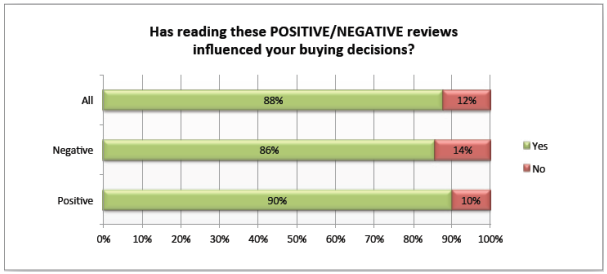
From the percentage mentioned in the chart it is evident that the customers’ decisions were highly influenced by the positive or negative reviews posted on the web. Further, it has become a trend to read reviews of products and/or services before deciding to buy them. The following chart depicts the results of the survey conducted by Gesenhues (2013).
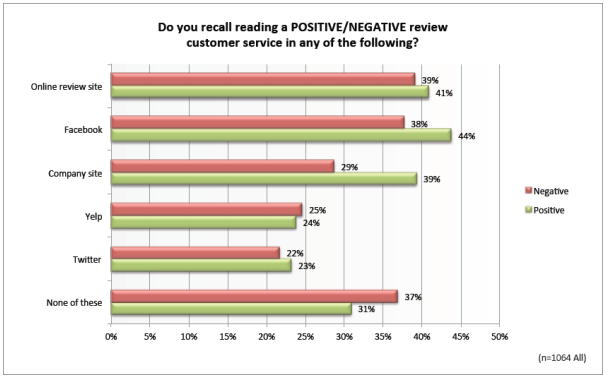
As is evident from the chart, most of the answers pertaining to various websites are on the positive side. Considering all the above charts, it can be concluded that the customers share their experiences and based on that, future customers decide their preferences.
Customer engagement – word of mouth publicity
Word of mouth publicity is a crucial factor in increasing or decreasing the value of a product (Buttle 1998). Customers are neither friends nor enemies of the companies that manufacture products. Customers form opinions about products or services according to their own experiences. Such experiences might be good or bad, depending on the quality and value for price of the product or service.
It is a human tendency to share their experiences with people they know. According to a survey conducted by Gesenhues (2013), almost 100% of people earning more than 150,000 dollars, usually share their good and/or bad experiences with their acquaintances. Other categories mentioned in the chart also have the tendency of sharing their good/bad experiences with people. The following chart depicts the results:
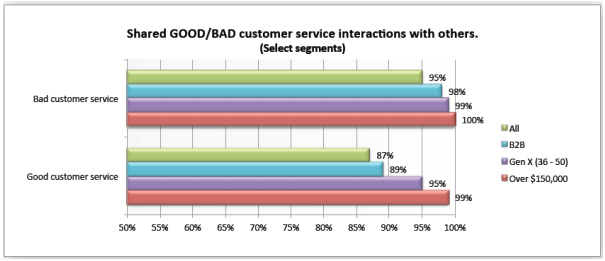
Conclusion
In conclusion, it is evident that nowadays customers value experience more than the product or the service. Even surveys conducted show that customers are influenced by the experience of others as well as their own encounters.
Companies try hard to come up to the expectations of their customers and give better experiences to their customers so that they are satisfied and promote their products or services among their acquaintances. Customers gather experience only after using a particular product or service.
Product and service are generally misunderstood as being similar in their nature because both are related to customers. But in fact, these two have their own distinguished features. Products are tangible and can be seen, felt, and smelled whereas, service is intangible and cannot be seen, felt, or smelled.
Products can be resold for profit but services don’t have this feature. Services are to be used by the buyer himself (they are non-transferable). Whereas, the ownership of products can be transferred at the owner’s will.
Due to the ever-expanding customer demands, new entrants are launching their products in the market. This has posed a great danger for the established companies. Companies adopt various strategies to overcome such competition. But in their endeavours to sustain the competition, companies ought to follow certain moral codes of conduct. This applies to both the new entrants and the established companies.
Organizations have now understood that customers’ experiences play a vital role in their decisions and preferences. So, companies involve their customers in important developments pertaining to products and/or services. By doing this, companies are able to take advantage of their customers’ experiences and develop new products and/or services based on such experiences.
References
Buttle, F. 1998, Word of mouth: Understanding and managing referral marketing. Web.
Court, D., Elzinga, D., Mulder, S., & Vetvik, O. 2009, The consumer decision journey. Web.
Dess, G. 2010, Strategic Management, McGraw-Hill, New York.
Dudik, E. 2000, Strategic renaissance. Web.
Fortify-and-defend strategy 2013. Web.
Gesenhues, A. 2013, Survey: 90% of customers say buying decisions are influenced by online reviews. Web.
Hartman, D. & Lindgren, J. 1993, ‘Consumer evaluations of goods and services’, Journal of Services Marketing, vol. 7. no. 2, pp. 4-15.
Heskett, J., Jones, T., Loveman, G., Sasser, E., & Schlesinger, G. 1994, Putting the service-profit chain to work. Web.
Johansson, K. & Furuskar, A., Cost efficient capacity expansion strategies using multi-access networks. Web.
Korhonen, K. 2012, Value co-creation approach in B2B-service. Web.
Lister, J. 2013, Differences between offensive and defensive marketing. Web.
Lusch, R. & Vargo, S. 2011, ‘Service-dominant logic: A necessary step’, European Journal of Marketing, vol. 45. no. 7/8, pp. 1298-1309.
McPartlin, S. & Dugal, L. 2011, Understanding how US online shoppers are reshaping the retail experience. Web.
Parry, G., Newnes, L., & Huang, X. 2011, Goods, products and services. Web.
Rathmell, J. 1966, ‘What is meant by services?’, Journal of Marketing, vol. 30. no. 1, pp. 32-36.
Spreckley, F. & Hunt, S. 2008, Marketing toolkit. Web.
Stufflebeam, D. 2001, Evaluation values and criteria checklist. Web
Vargo, S. & Lusch, R. 2004, ‘The four service marketing myths: Remnants of a goods-based, manufacturing model’, Journal of Service Research, vol. 6. no. 4, pp. 324-335.
Vargo, S. & Lusch, R. 2008, ‘Why service?’, Journal of the Acad. Mark. Sci., vol. 36. no.1, pp. 25-38.
Wolak, R., Kalafatis, S., & Harris, P. 1998, ‘An investigation into four characteristics of services’, Journal of Empirical Generalizations in Marketing Science, vol. 3. no. 1, pp. 22-43.
Yamamoto, G., Understanding customer value concept: Key to success. Web.
Yannopoulos, P. 2011, ‘Defensive and offensive strategies for market success’, International Journal of Business and Social Science, vol. 2. no. 13, pp. 1-12.
Yoffie, D. & Kwak, M. 2002, ‘Judo strategy: 10 techniques for beating a stronger opponent’, Business Strategy Review, vol. 13. no. 1, pp. 20-30.
Zeithaml, V. 1981, How consumer evaluation processes differ between goods and services. Web.